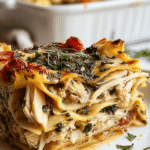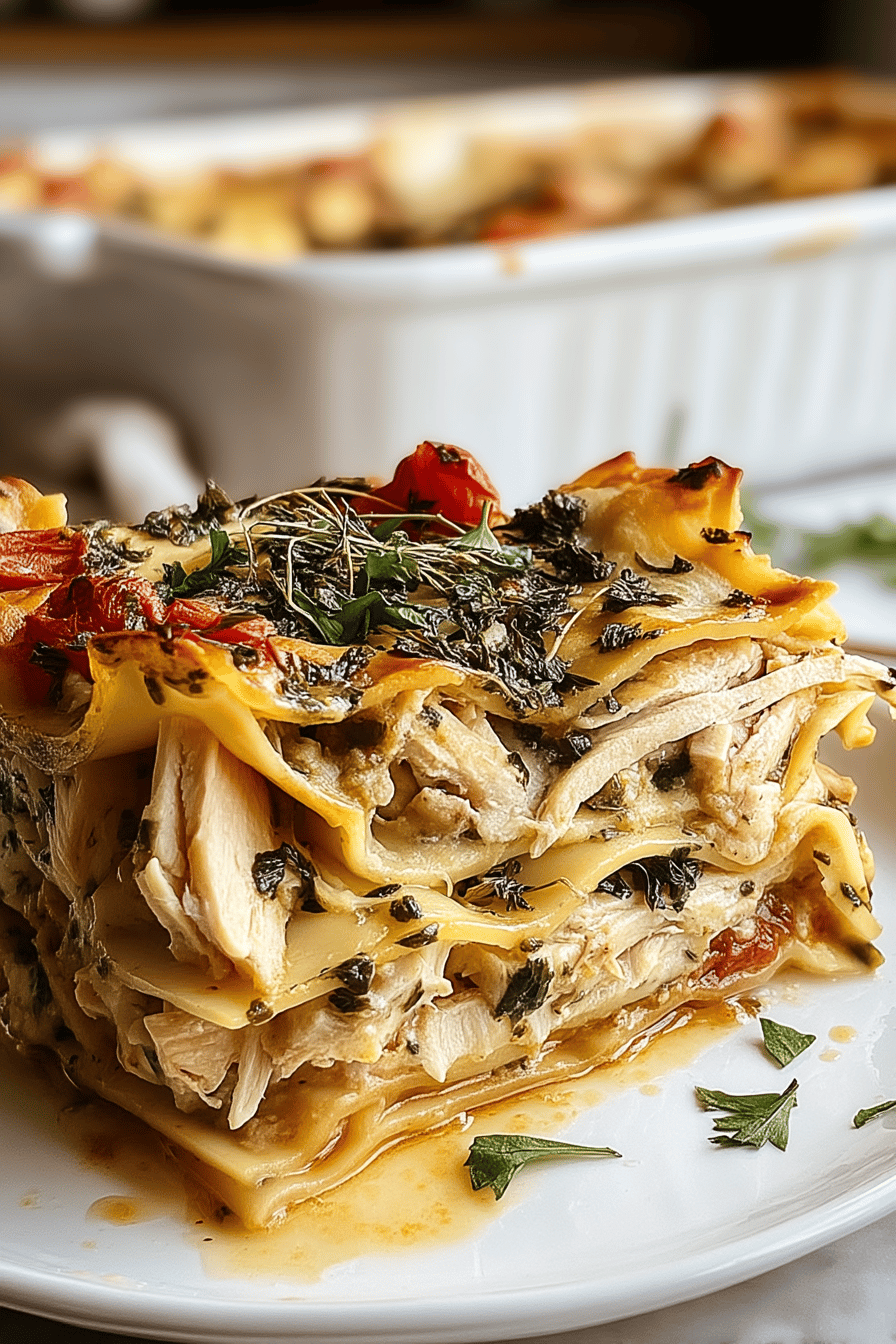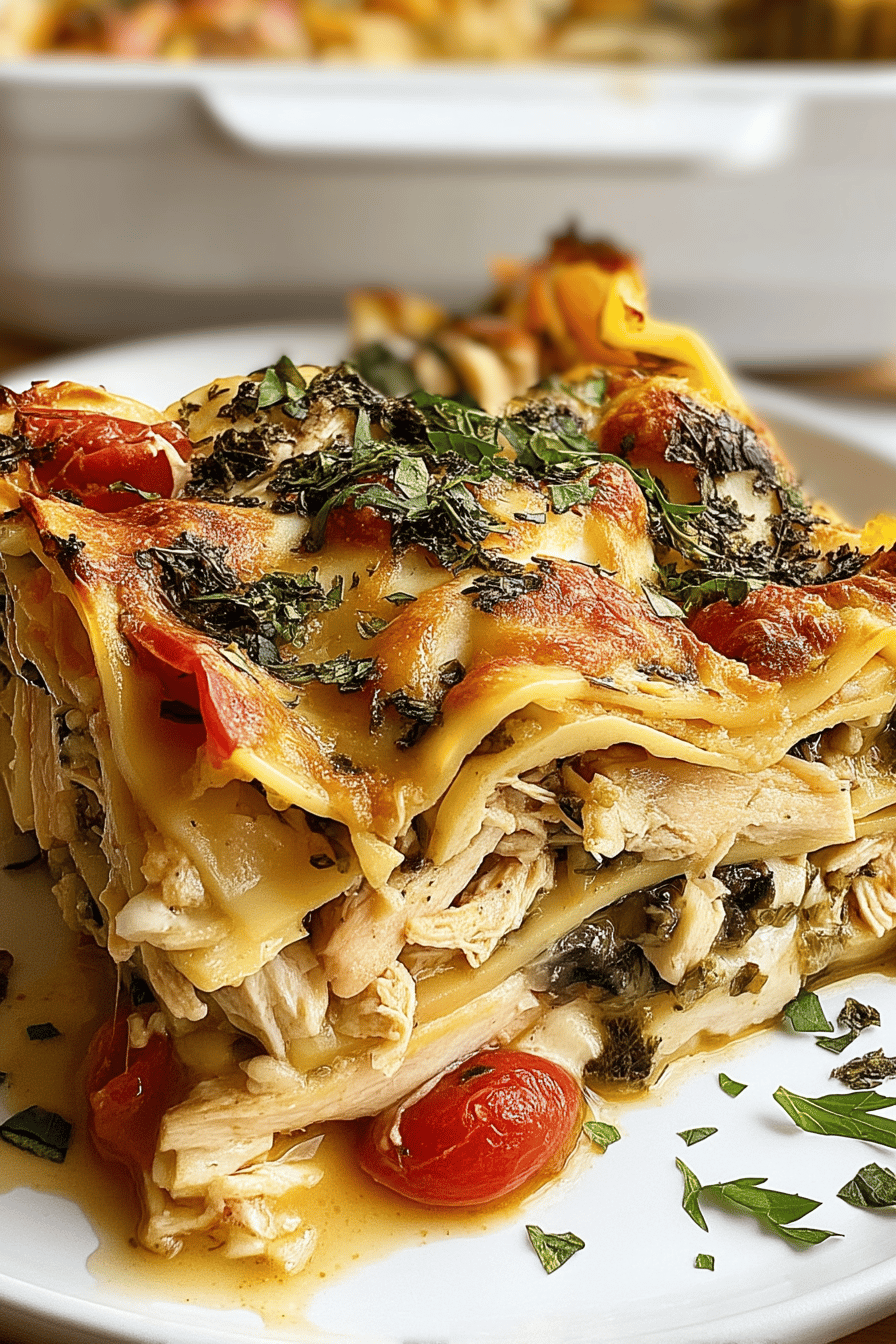Why You’ll Love This Vegan Lasagna
If you’re searching for a satisfying vegan lasagna that’s both comforting and easy to whip up, you’re in for a treat with this hearty recipe. This vegan lasagna layers rich flavors and wholesome ingredients into a dish that’s perfect for family dinners or meal prep. Let’s highlight the key perks that make vegan lasagna a go-to choice for home cooks everywhere.
- Ease of preparation: Vegan lasagna comes together with straightforward steps, taking just 25 minutes to prep and 1 hour to cook for a total of 1 hour 25 minutes, making it ideal for busy parents or students. You can assemble it ahead without fuss, using simple ingredients like lentils and no-boil noodles, which cuts down on effort and cleanup. This simplicity ensures vegan lasagna fits seamlessly into your routine, even on weeknights.
- Health benefits: This recipe boasts nutritional perks from plant-based components, such as fiber-rich lentils and nutrient-dense veggies, providing about 497 calories per serving with 25g protein, 14g fiber, and vitamins like A and C. It supports wellness by offering heart-healthy fats from cashews and antioxidants from marinara, while keeping sodium in check at 700mg per serving. You’ll appreciate how vegan lasagna delivers a balanced, nourishing meal that’s great for diet-conscious individuals seeking flavorful, everyday options.
- Versatility: Vegan lasagna adapts easily to various dietary needs, from gluten-free swaps to nut-free adjustments, letting you tweak it for personalized tastes or restrictions. Whether for travelers packing light or seniors preferring milder flavors, you can modify herbs, veggies, or noodles to suit your preferences. This flexibility makes vegan lasagna a reliable dish for any occasion, from intimate dinners to larger gatherings.
- Distinctive flavor: What sets this vegan lasagna apart is the creamy cashew-tofu ricotta paired with a savory lentil-marinara base, creating a delicious depth that’s both hearty and fresh. The added sautéed vegetables and herbs like basil and oregano bring a Mediterranean twist, while the golden vegan cheese topping adds a satisfying crunch. You’ll love how vegan lasagna transforms simple ingredients into a standout meal with its layered, comforting taste.
Overall, vegan lasagna offers a blend of ease, nutrition, and flavor that keeps it exciting, so grab your ingredients and enjoy!
Jump To
- 1. Why You’ll Love This Vegan Lasagna
- 2. Essential Ingredients for Vegan Lasagna
- 3. How to Prepare the Perfect Vegan Lasagna: Step-by-Step Guide
- 4. Dietary Substitutions to Customize Your Vegan Lasagna
- 5. Mastering Vegan Lasagna: Advanced Tips and Variations
- 6. How to Store Vegan Lasagna: Best Practices
- 7. FAQs: Frequently Asked Questions About Vegan Lasagna
- 8. Vegan Lasagna
Essential Ingredients for Vegan Lasagna
Gathering the right ingredients is key to making a delicious vegan lasagna that’s packed with flavor and nutrition. Below is a comprehensive list with precise measurements and explanations, helping you understand how each component contributes to the dish. This setup ensures your vegan lasagna turns out perfectly every time.
Main Ingredients
- 1 cup dried red lentils – Provide a hearty, protein-packed base that replaces meat, adding about 25g protein per serving for a satisfying texture.
- 2 25-ounce jars marinara sauce (or about 50 ounces total of your preferred marinara sauce) – Form the flavorful sauce foundation, infusing the dish with tangy tomato goodness and vitamins.
- 1 cup raw cashews – Create a creamy ricotta substitute when blended, contributing healthy fats and a nutty richness to the vegan lasagna.
- 1 14.5-ounce package firm tofu, patted dry – Acts as the base for the ricotta, mimicking cheese’s creaminess while boosting protein without dairy.
- 1/2 cup nutritional yeast – Adds a cheesy flavor and B vitamins, enhancing the ricotta’s taste and nutritional profile.
- 3 tablespoons fresh lemon juice (from about 2 lemons) – Brings acidity to the ricotta, balancing flavors and aiding in a smooth blend.
- 1 teaspoon salt – Seasons the ricotta mixture evenly, drawing out the natural tastes of the ingredients in vegan lasagna.
- 1 teaspoon dried basil – Infuses herbal notes that complement the marinara, adding depth and an Italian-inspired flair.
- 1 teaspoon oregano – Contributes earthy warmth to the ricotta and sauce, enhancing the overall Mediterranean vibe.
- 1/2 teaspoon garlic powder – Provides a convenient aromatic boost, simplifying prep while adding savory undertones.
- 3 cups baby spinach – Adds fresh greens for volume and nutrients like iron, layering in vitamins for a healthier vegan lasagna.
- 1 box lasagna noodles (about 12 noodles; regular, gluten-free, or whole grain; no-boil option can be used to save time) – Form the structure, holding everything together with options for quick assembly.
- 2-3 cups shredded vegan cheese (for topping; or make it nut-free by substituting with more tofu) – Creates a melty top layer, adding a crispy finish while keeping it fully plant-based.
- 1 1/2 tablespoons olive oil (for sautéing vegetables) – Helps cook veggies for added flavor, providing healthy fats in the process.
- 1 medium-sized onion, diced – Builds a savory base when sautéed, releasing sweetness and depth into the vegan lasagna.
- 5 cloves garlic, minced – Adds pungent aroma and flavor, enhancing the vegetable mix without overpowering.
- 1 large eggplant (about 14 ounces, cubed) – Offers hearty texture and nutrition, absorbing flavors during cooking.
- 2 large carrots, diced – Brings natural sweetness and fiber, boosting the vegetable layer’s health benefits.
- 8 ounces mushrooms, sliced – Adds earthy umami and moisture, making the filling more robust and delicious.
Special Dietary Options
- Vegan: This recipe is already fully vegan, but for nut-free versions, replace cashews with silken tofu in the ricotta to maintain creaminess.
- Gluten-free: Use gluten-free lasagna noodles to keep the dish intact, ensuring all other ingredients remain as listed for a seamless swap.
- Low-calorie: Reduce oil to 1 tablespoon and skip extras like vegan cheese on top, focusing on veggies for a lighter take on vegan lasagna without sacrificing taste.
How to Prepare the Perfect Vegan Lasagna: Step-by-Step Guide
Vegan lasagna is a breeze to prepare, with just 25 minutes of prep and 1 hour of cooking for a total of 1 hour 25 minutes, making it perfect for family meals or gatherings. This guide walks you through the process, from cooking lentils to baking the layers, with tips for adapting to dietary needs like gluten-free or nut-free options. Whether you’re a beginner home cook or feeding a crowd, these steps ensure your vegan lasagna turns out flavorful and satisfying every time.
First Step: Cook the Lentils and Prepare the Ricotta
Start by gathering all ingredients on your counter this mise en place keeps everything organized for vegan lasagna. Cook 1 cup dried red lentils in 3 cups water by bringing to a boil, then simmering for 20 minutes until tender; drain and mix with 2 25-ounce jars marinara sauce for the base. For the ricotta, process 1 cup raw cashews in a blender until crumbly, add 1 14.5-ounce package firm tofu (patted dry), 1/2 cup nutritional yeast, 3 tablespoons fresh lemon juice, 1 teaspoon salt, 1 teaspoon dried basil, 1 teaspoon oregano, and 1/2 teaspoon garlic powder, then blend until smooth, adding water if needed for consistency. If making nut-free, substitute cashews with more tofu here to keep the texture creamy and adaptable.
Second Step: Sauté the Vegetables
Next, in a pan over medium heat, warm 1 1/2 tablespoons olive oil and sauté 1 medium-sized onion (diced) and 5 cloves garlic (minced) for about 5 minutes until translucent. Add 1 large eggplant (about 14 ounces, cubed), 2 large carrots (diced), and 8 ounces mushrooms (sliced), along with 3/4 teaspoon salt and 1/2 teaspoon ground black pepper, and cook for 10 minutes until tender this step enhances flavor and adds texture. For low-calorie adaptations, use less oil or skip it entirely, relying on the veggies’ natural juices to build the base of your vegan lasagna.
Third Step: Assemble the Lasagna
Once veggies are ready, preheat the oven to 350 degrees Fahrenheit and coat a 9×13-inch baking dish with a light oil spray. Spread 1 cup of the lentil-marinara mixture on the bottom of the dish, then layer with 4-5 lasagna noodles (using no-boil for speed), half the cashew-tofu ricotta, half the 3 cups baby spinach, and 1 cup marinara; repeat the layers, ending with noodles and the remaining marinara on top. This assembly takes about 10 minutes and allows for gluten-free noodles if needed, ensuring your vegan lasagna suits various preferences.
Fourth Step: Bake and Add Toppings
After assembling, cover the dish with foil and bake for 40 minutes until the noodles are tender this gentle heat melds the flavors. Uncover, sprinkle 2-3 cups shredded vegan cheese over the top, and bake for an additional 20 minutes until browned and bubbly. If incorporating a vegan meat alternative for heartier results, add it in the layers here, and for dietary tweaks, monitor baking time for low-calorie versions to prevent overcooking.
Fifth Step: Cool and Serve
Once baked, remove the lasagna from the oven and let it cool for at least 15 minutes to set, making it easier to slice and serve. This resting period allows flavors to settle, and you can adjust for nut-free by ensuring all toppings are compatible. Your vegan lasagna is now ready, serving 8 with a mix of hearty textures and tastes.
Final Step: Finishing Touches and Serving
To finish, garnish with fresh herbs like basil or parsley for a pop of color and flavor, then cut into portions for sharing. Each serving brings around 497 calories with 25g protein and key nutrients, making it a wholesome option pair with sides from our broccoli chicken alfredo casserole if you want variety, though it’s optional. Serve hot for the best experience, adapted to your needs, and savor the comforting layers of vegan lasagna that make it a crowd-pleaser.
Dietary Substitutions to Customize Your Vegan Lasagna
Protein and Main Component Alternatives
Customizing the protein in vegan lasagna lets you adapt it for different diets while keeping it delicious. For a nut-free version, replace the cashews in the ricotta with silken tofu or a store-bought nut-free alternative, maintaining creaminess without altering the base. If lentils aren’t available, swap the 1 cup dried red lentils with chickpeas or a vegan meat substitute for similar texture and protein, ensuring your vegan lasagna remains hearty and satisfying.
Vegetable, Sauce, and Seasoning Modifications
Adjusting vegetables makes vegan lasagna flexible for seasons or preferences, like subbing eggplant for bell peppers to add crunch. For sauces, tweak the marinara by incorporating fresh tomatoes or herbs for a lighter twist, and change seasonings by reducing oregano for milder flavors or adding smoked paprika for a smoky note. These changes help tailor vegan lasagna to dietary needs, such as low-sodium options by cutting back on salt.
Mastering Vegan Lasagna: Advanced Tips and Variations
Enhancing your vegan lasagna with expert tips can make it even more enjoyable, from perfecting techniques to trying new twists. These suggestions help you customize the recipe for success and add flair to your meals.
Pro Cooking Techniques
Use a high-powered blender for smoother ricotta and sauté vegetables in batches for even flavor in your vegan lasagna.
Flavor Variations
Experiment with seasonings like swapping basil for fresh spinach or adding spices for a global twist on vegan lasagna.
Presentation Tips
Plate with a sprinkle of herbs for visual appeal, slicing neatly to show layers in your vegan lasagna.
Make-Ahead Options
Prep the ricotta and veggie mix ahead, storing separately to save time, so your vegan lasagna is ready for quick assembly.
How to Store Vegan Lasagna: Best Practices
Proper storage keeps your vegan lasagna fresh and tasty, whether for daily meals or longer holds. Here’s how to handle it step by step.
- Refrigeration: Keep in an airtight container in the fridge for up to 4 days to maintain the texture and flavors of vegan lasagna.
- Freezing: Freeze in portions for up to 3 months, using freezer-safe containers to preserve quality for later.
- Reheating: Warm in a 350 degrees Fahrenheit oven for 20-30 minutes until heated through, ensuring safety and taste.
- Meal Prep Considerations: Divide into servings for easy reheating, making vegan lasagna a handy option for busy weeknights.
FAQs: Frequently Asked Questions About Vegan Lasagna
Can I use different types of lentils in vegan lasagna if I don’t have red lentils?
Yes, you can substitute brown or green lentils for red lentils in vegan lasagna. Brown and green lentils keep their shape more and don’t soften as much as red lentils, so the texture will be a bit firmer in the sauce. The flavor remains delicious, but the sauce may be less creamy compared to using red lentils. Choose based on your texture preference.
How can I make vegan lasagna gluten-free?
To make vegan lasagna gluten-free, simply replace regular lasagna noodles with gluten-free ones, which are widely available at most grocery stores. Make sure to check the packaging for vegan certification to avoid hidden animal products. Gluten-free noodles may require slightly different cooking times, so follow the package instructions for best results.
What side dishes pair well with vegan lasagna?
Vegan lasagna goes well with a variety of simple and fresh side dishes. Garlic bread made with vegan butter or olive oil is a classic choice. For veggies, steamed or roasted greens such as broccoli, asparagus, or a fresh mixed salad with a light vinaigrette balance the richness of the lasagna. These sides add texture and freshness to the meal.
Can I prepare vegan lasagna ahead of time and still get great results?
Yes, vegan lasagna can be assembled a day in advance and stored in the refrigerator before baking. You can also bake it fully, let it cool, and refrigerate overnight. When ready to eat, reheat in the oven until warmed through and bubbly, which helps flavors meld together beautifully. This makes it perfect for meal planning or entertaining.
What’s the best way to store and reheat leftover vegan lasagna?
Store leftover vegan lasagna in an airtight container or cover the casserole dish tightly with plastic wrap and foil. It can be kept in the fridge for up to 4 days. For reheating, warming in a 350°F oven for 20-30 minutes until heated through and slightly bubbly is ideal. Alternatively, microwaving individual portions works well for a quicker option.

Vegan Lasagna
- Total Time: 1 hour 25 minutes
- Yield: 8 servings 1x
- Diet: Vegan
Description
🌱 This Vegan Lasagna Best Recipe Guide combines hearty lentils with creamy homemade tofu ricotta for a nutritious and satisfying meal.
🍅 The recipe offers customizable options including hearty sautéed vegetables and various noodle choices, making it perfect for any dietary preference or occasion.
Ingredients
1 cup dried red lentils
2 25-ounce jars marinara sauce
1 cup raw cashews
1 14.5-ounce package firm tofu, patted dry
1/2 cup nutritional yeast
3 tablespoons fresh lemon juice
1 teaspoon salt
1 teaspoon dried basil
1 teaspoon oregano
1/2 teaspoon garlic powder
3 cups baby spinach
1 box lasagna noodles (about 12 noodles; regular, gluten-free, or whole grain; no-boil option can be used)
2–3 cups shredded vegan cheese for topping
1 1/2 tablespoons olive oil for sautéing vegetables
1 medium-sized onion, diced
5 cloves garlic, minced
1 large eggplant (about 14 ounces, cubed)
2 large carrots, diced
8 ounces mushrooms, sliced
Instructions
First Step: Cook the Lentils and Prepare the Ricotta Start by gathering all ingredients on your counter this mise en place keeps everything organized for vegan lasagna. Cook 1 cup dried red lentils in 3 cups water by bringing to a boil, then simmering for 20 minutes until tender; drain and mix with 2 25-ounce jars marinara sauce for the base. For the ricotta, process 1 cup raw cashews in a blender until crumbly, add 1 14.5-ounce package firm tofu (patted dry), 1/2 cup nutritional yeast, 3 tablespoons fresh lemon juice, 1 teaspoon salt, 1 teaspoon dried basil, 1 teaspoon oregano, and 1/2 teaspoon garlic powder, then blend until smooth, adding water if needed for consistency. If making nut-free, substitute cashews with more tofu here to keep the texture creamy and adaptable.
Second Step: Sauté the Vegetables Next, in a pan over medium heat, warm 1 1/2 tablespoons olive oil and sauté 1 medium-sized onion (diced) and 5 cloves garlic (minced) for about 5 minutes until translucent. Add 1 large eggplant (about 14 ounces, cubed), 2 large carrots (diced), and 8 ounces mushrooms (sliced), along with 3/4 teaspoon salt and 1/2 teaspoon ground black pepper, and cook for 10 minutes until tender this step enhances flavor and adds texture. For low-calorie adaptations, use less oil or skip it entirely, relying on the veggies’ natural juices to build the base of your vegan lasagna.
Third Step: Assemble the Lasagna Once veggies are ready, preheat the oven to 350 degrees Fahrenheit and coat a 9×13-inch baking dish with a light oil spray. Spread 1 cup of the lentil-marinara mixture on the bottom of the dish, then layer with 4-5 lasagna noodles (using no-boil for speed), half the cashew-tofu ricotta, half the 3 cups baby spinach, and 1 cup marinara; repeat the layers, ending with noodles and the remaining marinara on top. This assembly takes about 10 minutes and allows for gluten-free noodles if needed, ensuring your vegan lasagna suits various preferences.
Fourth Step: Bake and Add Toppings After assembling, cover the dish with foil and bake for 40 minutes until the noodles are tender this gentle heat melds the flavors. Uncover, sprinkle 2-3 cups shredded vegan cheese over the top, and bake for an additional 20 minutes until browned and bubbly. If incorporating a vegan meat alternative for heartier results, add it in the layers here, and for dietary tweaks, monitor baking time for low-calorie versions to prevent overcooking.
Fifth Step: Cool and Serve Once baked, remove the lasagna from the oven and let it cool for at least 15 minutes to set, making it easier to slice and serve. This resting period allows flavors to settle, and you can adjust for nut-free by ensuring all toppings are compatible. Your vegan lasagna is now ready, serving 8 with a mix of hearty textures and tastes.
Final Step: Finishing Touches and Serving To finish, garnish with fresh herbs like basil or parsley for a pop of color and flavor, then cut into portions for sharing. Each serving brings around 497 calories with 25g protein and key nutrients, making it a wholesome option pair with sides from our broccoli chicken alfredo casserole if you want variety, though it’s optional. Serve hot for the best experience, adapted to your needs, and savor the comforting layers of vegan lasagna that make it a crowd-pleaser.
Notes
🌟 Use a good-quality marinara sauce or make your own for best results.
💧 Blend ricotta mixture smoother by adding water or soaking cashews before blending.
🥄 Pre-sauté vegetables to add flavor and texture to the lasagna.
⏰ Let lasagna cool after baking to improve texture and set properly.
🌿 Substitute lentils with vegan meat alternatives for variation.
🧀 Use extra shredded vegan cheese on top for a richer finish.
- Prep Time: 25 minutes
- Cook time: 1 hour
- Cook Time: 1 hour
- Category: Dinner
- Method: Baking
- Cuisine: Vegan, Italian-inspired
Nutrition
- Serving Size: 1 serving
- Calories: 497
- Sugar: 11g
- Sodium: 700mg
- Fat: 12g
- Saturated Fat: 2g
- Carbohydrates: 75g
- Fiber: 14g
- Protein: 25g
- Cholesterol: 0mg
Keywords: vegan lasagna,tofu ricotta,plant-based lasagna,lentil lasagna


